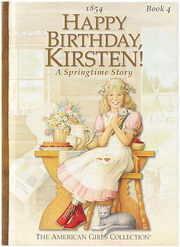
Title: Happy Birthday Kirsten!
Author: Janet Shaw
Illustrator: Renee Graff
Genre: Historical Fiction
Summary
Kirsten Larson is a pioneer girl who lives on the Minnesota prairie in 1854. Happy Birthday Kirsten (A springtime story) is the fourth book in the American Girls Series about Kirsten. This specific story takes place in the spring. Many new things are coming to the Larson family this spring. The family is expecting a new baby girl and a big new barn. These changes bring worries to Kirsten though because she is worried about her mother’s health during the pregrancy and she has to take over most of her mother’s chores. Before taking over her mother chores, Kirsten and her friends begin making a quilt at school that they were planning to give Miss Winston, their teacher, as a gift of appreciation. However, Kirsten is unable to contribute much to the making of the quilt so Miss Winston and the other girls decide to make it for Kirsten’s tenth birthday instead. A few weeks after the baby is born, Kirsten’s family throws her a birthday party. All her friends and their families are there to put up the new barn and to celebrate Kirsten’s tenth birthday. At the celebration, Kirsten’s friends present her with the quilt they made for her and they tell her it is a friendship quilt. Each person signs the friendship quilt. Kirsten has so much fun at her birthday party and does not think another birthday will top this one.
Classroom Connection
Happy Birthday Kirsten is a historical fiction book. Students could research the 1850’s and 1860’s to see how people actually lived during this time. Students could then make comparisions between things that happened in the book and things they found out while researching this time period.
At the beginning of the year the class could read this book aloud or for homework on their own. Once everyone was finished, I would discuss a fun activity that we could do in relation to this book throughout the entire year. Whenever it is someone’s birthday in the class, each person would be handed a piece of paper that was in the shape of a square and they would decorate it for whoever’s birthday it was. Once everyone was done, we could put the square pieces together and the birthday boy or girl would have a “birthday quilt” to take home with them from the class.
















